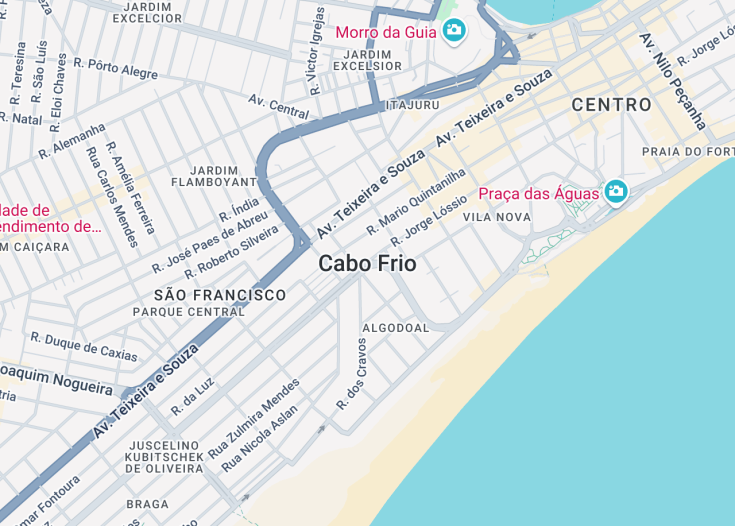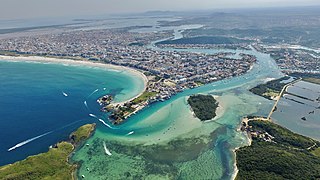Cabo Frio, located in the state of Rio de Janeiro, Brazil, is a premier coastal destination known for its stunning white-sand beaches, crystal-clear turquoise waters, and vibrant marine life. A center for water sports enthusiasts, the area is renowned for wind and kite surfing due to its consistent winds.
Visitors are also drawn to the historical charm of its town, lined with colonial architecture, amidst a lively market selling artisanal crafts and local cuisine. The combination of natural beauty and cultural richness makes Cabo Frio a captivating destination for travelers seeking both relaxation and adventure.
Plan your visit during the low season, from May to September, to enjoy Cabo Frio’s beauty with fewer crowds and mild weather, enhancing your experience of its beaches and local culture.
Don’t miss a boat trip to the nearby islands—Ilha do Japonês and Ilha do Papagaio—for a pristine beach experience and excellent snorkeling opportunities.
How to best experience Cabo Frio?
Tickets, tours, and activities for Cabo Frio are available at these providers:
Click on the logos below to easily compare prices.

Feeling lucky? Try the direct search:
GetYourGuide.com Viator.com Trip.com Expedia.com Tiqets.com Ctrip.com (中文)
Cabo Frio: A Brazilian Coastal Paradise
| Country | Brazil |
| Time in Cabo Frio | GMT-3 |
| Language spoken | Portuguese |
| Population | 230,000 (IBGE 2021) |
| Currency | Brazilian Real (R$ / BRL) |
| Airports | Cabo Frio International Airport (7 mi / 11 km). |
Cabo Frio, located in the Brazilian state of Rio de Janeiro, is an enchanting coastal city known for its stunning beaches, vibrant atmosphere and rich historical background. Its name, which translates to ‘Cold Cape’, originated from the cold underwater current that comes from the South Pole and bathes its shores. This geographic feature also enriches the local marine life, making Cabo Frio a hotspot for fishing and seafood. As one of the oldest cities in Brazil, Cabo Frio’s history is steeped in the times of early Portuguese exploration of Brazil.
Founded in 1615, its strategic location made it vital during the colonial era for defending the coast against potential invaders. Today, remnants of this period can still be seen in the centuries-old Portuguese forts, churches, and the charming colonial architecture that dots the city center. Tourists flock to Cabo Frio not just for its historical relics but also for its vibrant outdoor atmosphere. The city is famous for Praia do Forte, a sprawling white sand beach renowned for its crystal-clear blue waters, which stretches over 7.5 kilometers.
This beach is lined with a bustling promenade offering numerous restaurants, bars, and shops, making it a favorite for both locals and visitors. Beyond its spectacular coastlines, Cabo Frio is celebrated for its artisanal crafts, particularly intricate lacework, which is a traditional skill passed down through generations. The local cuisine, rich with seafood, provides a delightful culinary experience that pairs perfectly with the tropical climate.
Cabo Frio also serves as an excellent base for exploring nearby attractions, including the glamorous city of Búzios and the pristine Arraial do Cabo, often referred to as the Caribbean of Brazil due to its turquoise waters. Moreover, the city hosts a variety of cultural festivals throughout the year, with the most famous being the Cabo Frio International Festival of Latin-American Cinema and the annual carnival that rivals even Rio de Janeiro’s in its grandeur and intensity.
Whether it’s exploring historical sites, lounging on beautiful beaches, enjoying the local culture and cuisine, or participating in a variety of water sports, Cabo Frio offers a diverse array of activities that showcase the best of Brazil.
Where is Cabo Frio?
Cabo Frio is located in the south-eastern part of Brazil, along the coast of the Atlantic Ocean within the region of Rio de Janeiro state.
Distances:
Table with distance attributes pending completion.
What is Cabo Frio famous for?
Cabo Frio is renowned for its stunning beaches such as Praia do Forte, its rich history, and vibrant cultural scene, making it a premier destination in Brazil.
History
Pre-Colonial Period (Before 1500)
The history of Cabo Frio begins with its indigenous inhabitants, the Tupinambás, who were among the first people to inhabit the region. These early settlers exploited the rich marine resources of the area, living mainly from fishing and the gathering of shellfish.
The Era of European Discovery (1500-1600s)
Europeans first noted Cabo Frio in 1503, when the Italian navigator Amerigo Vespucci sailed along the Brazilian coast. Cabo Frio, meaning “Cold Cape” in Portuguese, takes its name from the chill offshore breezes that marked the encounter with its coastline. Subsequent to its discovery, European settlers were drawn to its shores due to the lucrative prospects of the brazilwood trade. The town was officially founded in 1615, serving initially as a hub for trade and defense against piracy and invasions.
Development and Trade (1600s-1800s)
Throughout the 17th and 18th centuries, Cabo Frio flourished as a center of salt production and fishing. Its strategic location made it an important point for the transport and trading of goods between Brazil and Europe. The town saw several conflicts during this period, including battles against French and Dutch invasions aimed at seizing control of the burgeoning trade in Brazilian commodities.
Modernization and Growth (1900s-Present)
The 20th century marked significant development for Cabo Frio, transitioning from a primarily trade-focused town into a popular tourist destination. Investments in infrastructure, such as roads and tourism facilities, helped to transform the area. Today, Cabo Frio is known for its beautiful beaches, vibrant cultural scene, and historical landmarks, inviting visitors from around the world to explore its rich heritage and natural beauty.
Visit Cabo Frio
What to see and do in Cabo Frio
Explore the stunning beaches of Cabo Frio, like Praia do Forte, with its clear waters and white sands stretching over 7.5 kilometers. Dive into history at the Forte São Mateus, a 17th-century fort that offers panoramic views of the coast.
Visit the charming neighborhood of Passagem, known for its preserved colonial architecture and vibrant nightlife.
- Museum of Naval History
- Surfing and water sports at Praia das Dunas
- Artisanal crafts at the local markets
Cultural Festivals and Events
Cabo Frio hosts several cultural events throughout the year. Noteworthy is the Festival of Latin Music, typically held in July, and the Cabo Frio International Film Festival, which lights up November nights.
These events not only offer entertainment but also showcase the rich cultural tapestry of the region.
Best time to visit Cabo Frio
The best time to visit Cabo Frio is between December and March when the weather is warm and sunny, perfect for beach activities and exploring the city.
Is Cabo Frio worth visiting?
Cabo Frio is undoubtedly worth a visit for anyone looking to experience a blend of natural beauty, historical richness, and cultural vibrancy.
The city’s well-preserved colonial architecture, coupled with its stunning coastal landscapes and a wide array of activities, makes it a unique destination in Brazil that appeals to a diverse range of interests.

